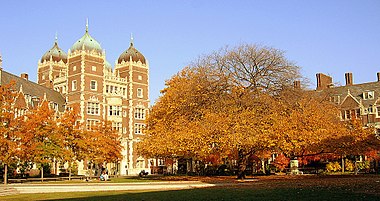The Pennsylvania Portal Pennsylvania (/ˌpɛnsɪlˈveɪniə/ PEN-sil-VAY-nee-ə, lit. 'Penn's forest country'), officially the Commonwealth of Pennsylvania (Pennsylvania Dutch: Pennsylvanie), is a landlocked state spanning the Mid-Atlantic, Northeastern, Appalachian, and Great Lakes regions of the United States. Pennsylvania borders Delaware to its southeast, Maryland to its south, West Virginia to its southwest, Ohio and the Ohio River to its west, Lake Erie and New York to its north, the Delaware River and New Jersey to its east, and the Canadian province of Ontario to its northwest. Pennsylvania was founded in 1681 through a royal land grant to William Penn, the son of the state's namesake. Prior to that, between 1638 and 1655, a southeast portion of the state was part of New Sweden, a Swedish Empire colony. Established as a haven for religious and political tolerance, the colonial-era Province of Pennsylvania was known for its relatively peaceful relations with native tribes, innovative government system, and religious pluralism. Pennsylvania played a vital and historic role in the American Revolution and the ultimately successful quest for independence from the British Empire, hosting the First and Second Continental Congress, leading to the adoption of the Declaration of Independence and the formation of the Continental Army. On December 12, 1787, Pennsylvania became the second state to ratify the U.S. Constitution. The bloodiest battle of the American Civil War, at Gettysburg over three days in July 1863, proved the war's turning point, leading to the Union's preservation. Throughout the late 19th and 20th centuries, the state's manufacturing-based economy contributed to the development of much of the nation's early infrastructure, including key bridges, skyscrapers, and military hardware used in U.S.-led victories in World War I, World War II, and the Cold War. Pennsylvania's geography is highly diverse. The Appalachian Mountains run through the center of the state; the Allegheny and Pocono mountains span much of Northeastern Pennsylvania; close to 60% of the state is forested. While it has no ocean shoreline, it has 140 miles (225 km) of waterfront along Lake Erie and the tidal Delaware River. (Full article...) This is a Featured article, which represents some of the best content on English Wikipedia..
Groundhog Day is a 1993 American fantasy romantic comedy film directed by Harold Ramis from a screenplay by him and Danny Rubin. Starring Bill Murray, Andie MacDowell, and Chris Elliott, it tells the story of a cynical television weatherman covering the annual Groundhog Day event in Punxsutawney, Pennsylvania, who becomes trapped in a time loop, forcing him to relive February 2 repeatedly. The film also features Stephen Tobolowsky, Brian Doyle-Murray, Marita Geraghty, Angela Paton, Rick Ducommun, Rick Overton, and Robin Duke in supporting roles. Rubin conceived the outline of Groundhog Day in the early 1990s. He wrote it as a spec script to gain meetings with producers for other work. It eventually came to the attention of Ramis, who worked with Rubin to make his idea less dark in tone and more palatable to a general audience by enhancing the comedy. After being cast, Murray clashed with Ramis over the script; Murray wanted to focus on the philosophical elements, whereas Ramis concentrated on the comedic aspects. Principal photography took place from March to June 1992, almost entirely in Woodstock, Illinois. Filming was difficult, in part because of bitterly cold weather but also because of the ongoing conflict between Ramis and Murray. (Full article...)Selected geography article -West Branch Fishing Creek is one of the northernmost major tributaries of Fishing Creek in Sullivan County, Pennsylvania and Columbia County, Pennsylvania, in the United States. It is 11.1 miles (17.9 km) long and flows through Davidson Township, Sullivan County and Sugarloaf Township, Columbia County. The creek's watershed has an area of 33.5 square miles, nearly all of which is forested land. Rock formations in the watershed of West Branch Fishing Creek include the Catskill Formation, the Huntley Mountain Formation, and the Burgoon Sandstone. North Mountain, Huckleberry Mountain, and Central Mountain are all in the creek's vicinity. The temperature of the creek's waters ranges from −2 °C (28 °F) to 23 °C (73 °F) and its pH ranges from approximately 5.5 to just under 7.0. The creek's discharge ranges from nearly 0 cubic meters per second to approximately 25 cubic meters per second. (Full article...)Selected image - Credit: Bryan Y.W. Shin The University of Pennsylvania in Philadelphia; the first university in the United States and a member of the Ivy League. Did you know -
Related portalsWikiprojectsThis is a Good article, an article that meets a core set of high editorial standards.
Pickett's Charge (July 3, 1863), also known as the Pickett–Pettigrew–Trimble Charge, was an infantry assault ordered by Confederate General Robert E. Lee against Major General George G. Meade's Union positions on the last day of the Battle of Gettysburg in Pennsylvania during the Civil War. Confederate troops made a frontal assault toward the center of Union lines, ultimately being repulsed with heavy casualties. Suffering from a lack of preparation and problems from the onset, the attack was a costly mistake that decisively ended Lee's invasion of the north and forced a retreat back to Virginia. The charge is popularly named after Major General George Pickett, one of three Confederate generals (all under the command of Lieutenant General James Longstreet) who led the assault. (Full article...)Selected article -
The Braddock expedition, also called Braddock's campaign or (more commonly) Braddock's Defeat, was a British military expedition which attempted to capture Fort Duquesne (established in 1754, located in what is now downtown Pittsburgh) from the French in the summer of 1755, during the French and Indian War of 1754 to 1763. The British troops suffered defeat at the Battle of the Monongahela on July 9, 1755, and the survivors retreated. The expedition takes its name from General Edward Braddock (1695–1755), who led the British forces and died in the effort. Braddock's defeat was a major setback for the British in the early stages of the war with France; John Mack Faragher characterises it as one of the most disastrous defeats for the British in the 18th century. (Full article...)
Pennsylvania news
CategoriesState factsState Facts
State symbols
Pennsylvania topicsGeneral imagesThe following are images from various Pennsylvania-related articles on Wikipedia.
Associated WikimediaThe following Wikimedia Foundation sister projects provide more on this subject:
Discover Wikipedia using portals
|
How Can We Help?



































































Recent Comments